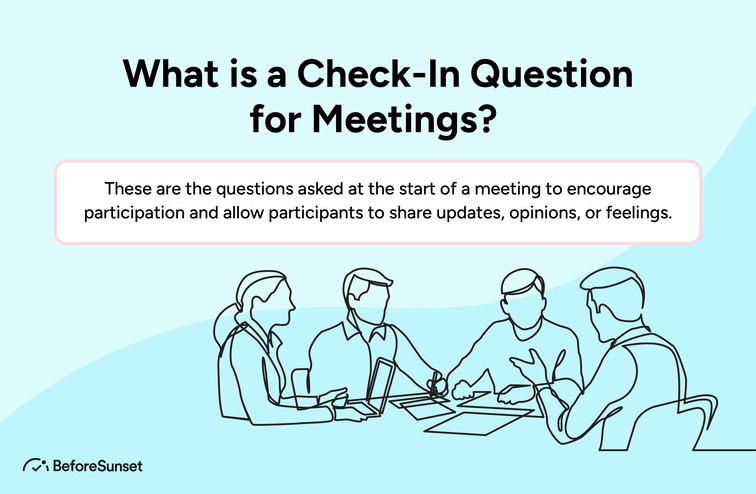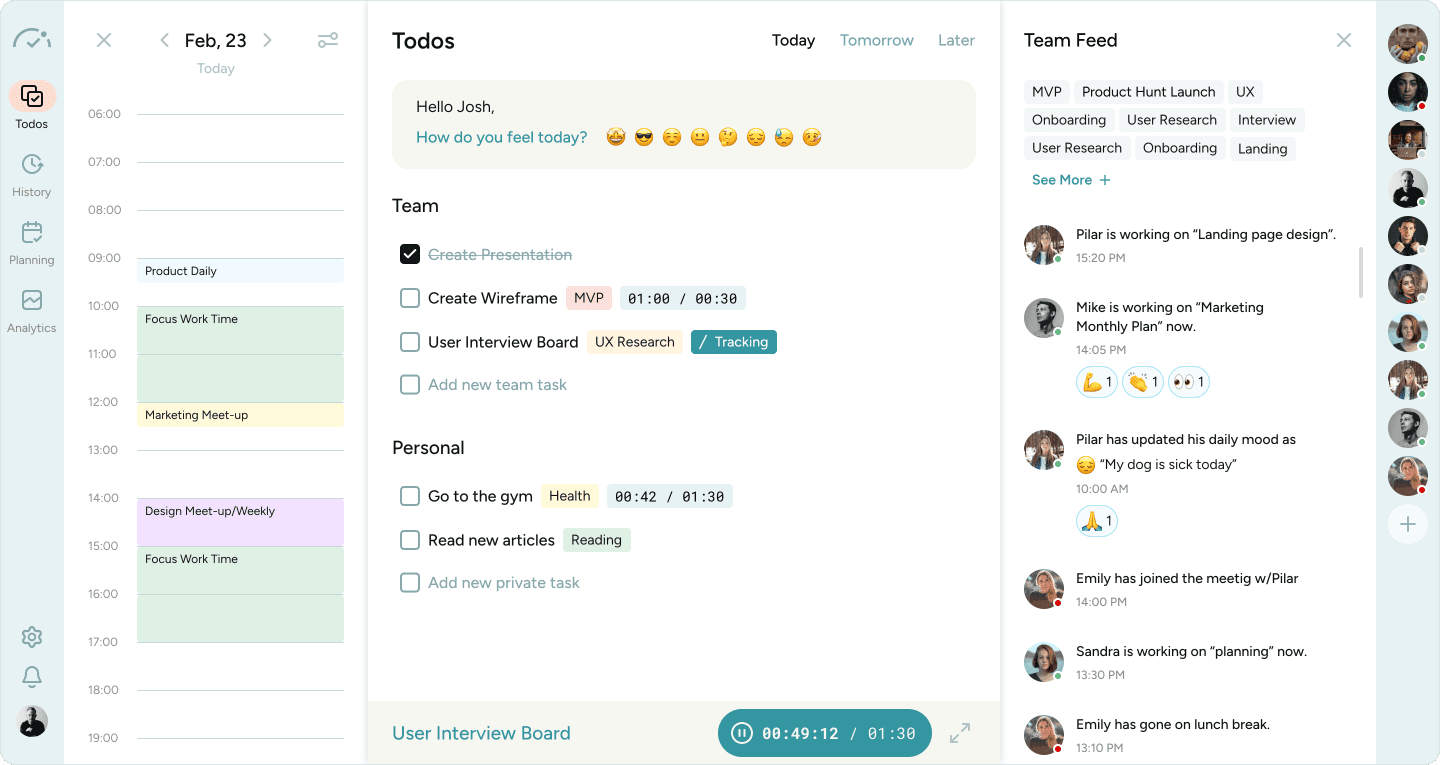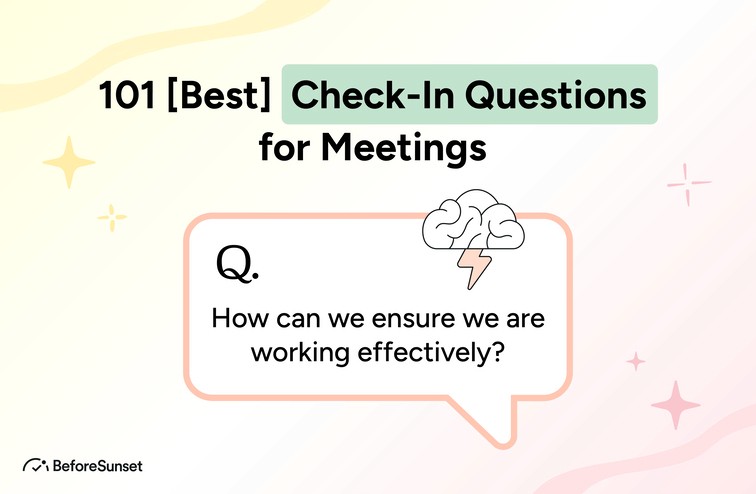Any successful team relies on effective communication. And it is especially important to have a strong and open line of communication in meetings, where individuals get together to exchange ideas and work toward a common objective.
Check-in questions are one technique to improve communication in meetings. Managers and team leaders, this blog is for you. Continue reading to learn about check-in questions for meetings and how they can help you establish a better, more cohesive team.
You may also like:

What is a Check-In Question?
Consider using check-in questions for meetings on a positive note and ensure everyone's participation. These are questions that are asked at the beginning of the meeting and help set the tone for the rest of the discussion.
To encourage participation, you can use open-ended questions that everyone feels comfortable answering. To help your team members connect, share updates, and set intentions for the meeting.
The purpose of check-in questions is to foster an environment where everyone feels comfortable sharing their thoughts and emotions.
By asking these questions, you demonstrate to your team members that their thoughts and perspectives are valued and considered. This contributes to the development of trust and respect within the team, which can result in enhanced collaboration and productivity.

Why Use Check-In Questions in Meetings?
The use of check-in questions for meetings is an effective technique for any group. They can facilitate more straightforward conversations, strengthen teams, and boost output.
If you're not already using check-in questions in your meetings, here are ten good reasons to start:
1. To help everyone stay on the same page
At the start of a meeting, check-in questions can assist team members in aligning. You can keep everyone up to date and on the same page by asking everyone to offer a brief update or highlight from their week.
2. To increase team transparency
You promote transparency when you encourage team members to share updates and thoughts during a check-in question. This can aid in fostering trust within the team and more open communication.
3. To identify blockers and address them
Check-in questions can also be used to identify problems or roadblocks that team members are experiencing. This can help you resolve these issues early and prevent them from growing into larger problems.
4. To identify and foster team cohesion
You can foster team cohesion and a sense of shared purpose by requesting team members to share updates or thoughts in response to a check-in question for meetings.
5. To increase team productivity
Team members are more likely to be productive when aligned and supported. Check-in questions may help in the development of a more supportive workplace, which can lead to higher productivity.
6. To foster open communication
Check-in questions allow team members to express their thoughts and emotions in a non-judgmental setting. This can help the team develop a more open and honest communication style.
7. To identify and promote employee wellbeing
When team members are asked to share updates or thoughts as part of a check-in question, there is an opportunity to identify any issues relating to employee wellbeing. This can assist managers or team leaders in providing assistance and resources to team members who may be struggling.
8. To increase productivity and efficiency
Check-in questions for meetings can also be used to identify any inefficiencies or roadblocks impeding the team's productivity. By addressing these issues early on, productivity and efficiency can be increased.
You can also use BeforeSunset AI to boost your team’s productivity. With BeforeSunset AI, you can share your progress with your team members if you want and see real-time updates from your team. Plus, you can learn about your teammate’s mood, so you get a heads up about their availability.

9. To build rapport and create a safe space
Building rapport and providing a safe space for team members to discuss their ideas and feelings can be accomplished by asking them to offer updates or thoughts during a check-in question.
10. To increase team satisfaction
Members of a team are more likely to be happy with their jobs if they have a strong sense of unity and backing from their coworkers. By fostering a more cooperative and encouraging atmosphere, check-in questions can boost team morale.

The Best 101 Check-In Questions for Meetings
1. What did you accomplish yesterday?
2. What will you accomplish today?
3. What are the obstacles impeding your progress?
4. How can the rest of the team help you?
5. How can the team help increase productivity?
6. Are there any new projects being added?
7. How are we doing so far?
8. What is being done to increase employee engagement?
9. How can we improve productivity?
10. Are there any updates on past projects?
11. What are some suggestions to improve workflow?
12. How can we keep up with the pace?
13. What are some ways to boost morale?
14. How can we ensure everyone is on the same page?
15. How can we improve communication?
16. Do we have enough resources to achieve our goals?
17. How can we ensure everyone is working toward the same goal?
18. How can we ensure we are working effectively?
19. How can we keep things rolling?
20. What is the best way to keep everyone in the loop?
21. How can we ensure everyone is well-informed?
22. What are some innovative ways to keep everyone on track?
23. What is your favourite time of day?
24. What should we do if something goes wrong?
25. How can we manage distractions?
26. What is the best way to handle interruptions?
27. What are some tips to increase focus and concentration?
28. Are there any new ideas or strategies that could be used?
29. How can we ensure our deliverables are met on time?
30. Are there any potential challenges that could arise in the future?
31. How can we ensure everyone works effectively as a team?
32. Are there any issues with communication between different departments or teams within the organisation?
33. How can we ensure everyone’s workload is balanced and manageable?
34. Is everyone feeling heard, understood, and appreciated in their roles within the team/organisation?
35. Are there any changes that could help improve collaboration among teams/departments within the organisation?
36. Is anyone feeling overwhelmed or underutilised in their current role(s)?
37. What did you learn today?
38. What are your goals for tomorrow?
39. How can we support you?
40. What blocks you from achieving your goals?
41. How can we improve team dynamics?
42. How do we measure success?
43. What are your biggest distractions?
44. What can we do better?
45. What type of support do you need?
46. Do you have any updates?
47. What are your career aspirations?
48. What would you like to accomplish this week?
49. What are your obstacles?
50. What are your strengths?
51. What can we do to improve efficiency?
52. How can we better communicate?
53. Do you have any questions?
54. How are we doing so far?
55. What motivates you?
56. How can we help you reach your goals?
57. What is your baseline?
58. How can we keep you happy?
59. What is your next step?
60. What can we do together?
61. What are your strengths?
62. How do we measure success?
63. What can we do to help you?
64. What are your goals for this meeting?
65. How will we know we've accomplished what we set out to do?
66. Do we have the resources we need to accomplish our goals?
67. How can we improve our meeting workflow?
68. What are some obstacles preventing us from reaching our goals?
69. How can we support each other in reaching our goals?
70. What feedback do we have for each other?
71. How can we keep each other accountable for reaching our goals?
72. What are some creative ways to stay engaged with our projects?
73. What are some ways we can boost team morale?
74. How can we stay healthy and engaged while we work?
75. What standout moments from our past projects can we learn from?
76. How can we keep everyone on board with our projects?
77. How can we help each other get unstuck when needed?
78. How can we use our unique team strengths to reach our goals?
79. How can we make the most of our check-in time?
80. What are some small wins we can celebrate along the way?
81. What do you need from us?
82. What ideas do you have to move the project forward?
83. What did you achieve yesterday?
84. What are your priorities for today?
85. How can we help?
86. What obstacles are you facing?
87. What feedback do you have?
88. What are your suggestions?
89. How can we improve our meetings?
90. What are your thoughts on the meeting agenda?
91. What are you working on right now?
92. What can we expect in the upcoming weeks?
93. What did you learn yesterday?
94. What are your thoughts on this idea?
95. How can we be better listeners?
96. What should we keep in mind?
97. What is your plan for the next hour?
98. What is your favourite part of this project?
99. What questions do you have for us?
100. What is the best way to reach you?
101. What past experience can help with this project?

Step 7: Use a digital daily planner to manage your schedule.
Consider using a digital daily planner to organize your calendar to ensure you have time for check-in. This might help you stay organized and guarantee that you have adequate time to complete each item on your agenda.
Step 8: Plan for distractions during meetings.
Distractions can disrupt the check-in process and undermine the meeting. To avoid distractions, turn off your phone, close your email, and notify your coworkers that you will be unreachable throughout the meeting.
Step 9: Monitor employee well-being survey questions each year.
To ensure the check-in questions remain relevant and effective, consider monitoring the employee well-being survey questions each year. This can help you to identify any issues that need to be addressed and adjust the check-in questions accordingly.
Step 10: Use project roadmap templates to create effective roadmaps.
Finally, project roadmap templates can be used to develop effective roadmaps. This can help to verify that the check-in questions for meetings are linked to the general goals and objectives of the project and that everyone on the team is working toward the same goals.
Check-In With Your Co-Workers With BeforeSunset
It is important to sync with your team to work in a healthier and more productive environment. Like how check-in questions for meetings improve your team's productivity, BeforeSunset AI can also enhance your team’s productivity by providing real-time updates from your team members.
You can also know your team’s mood, and team members can share their progress if they want. You can join the waitlist and be the first to use BeforeSunset AI.


